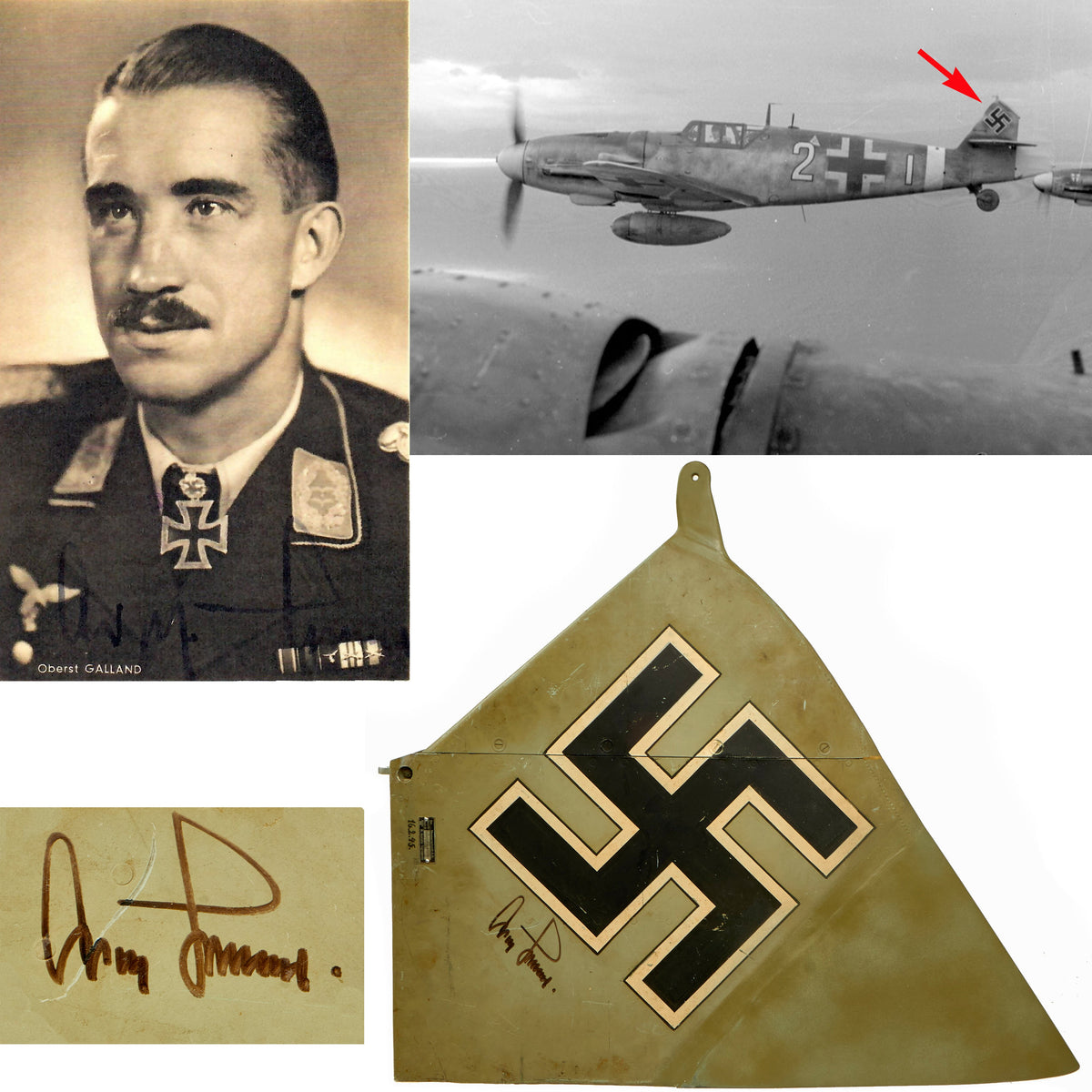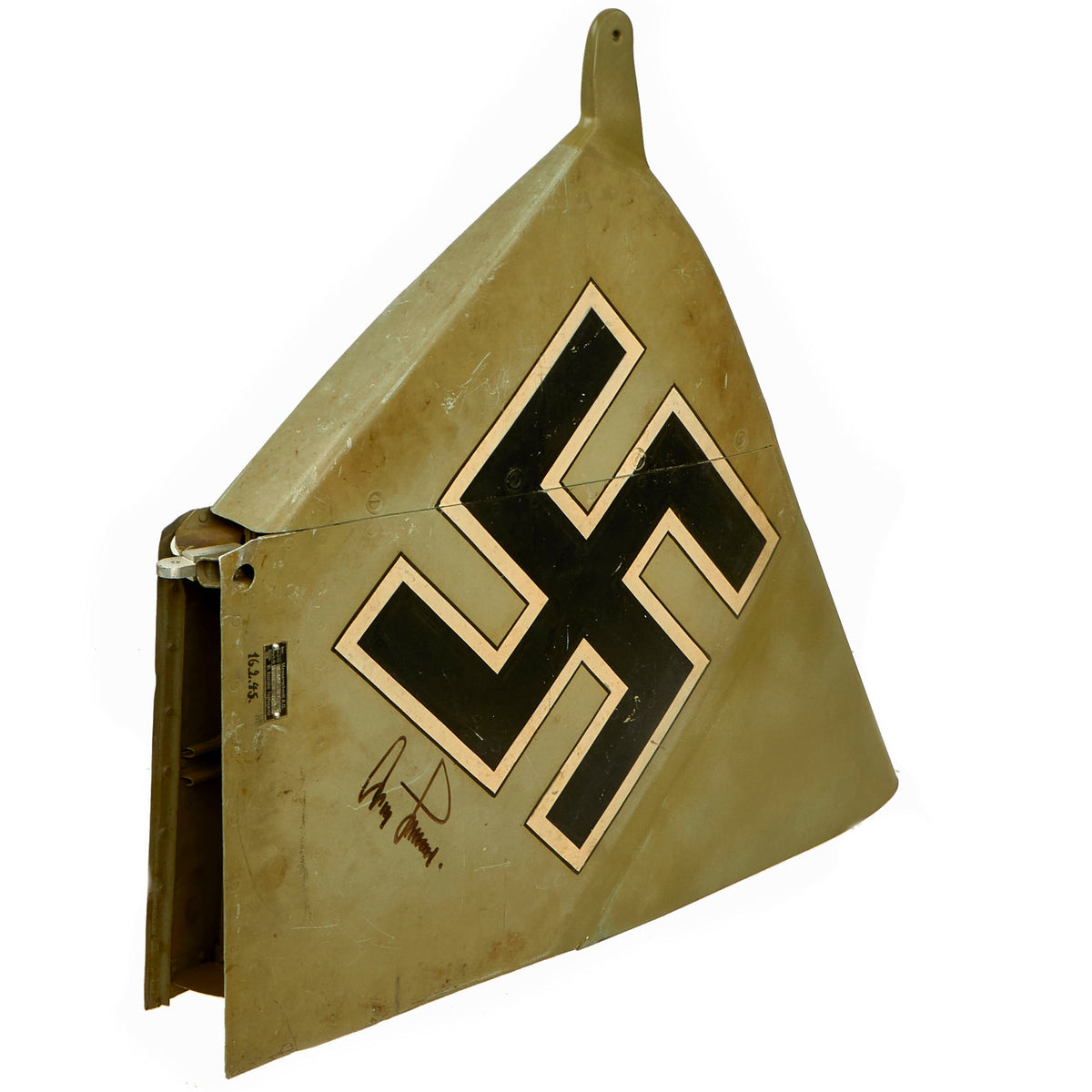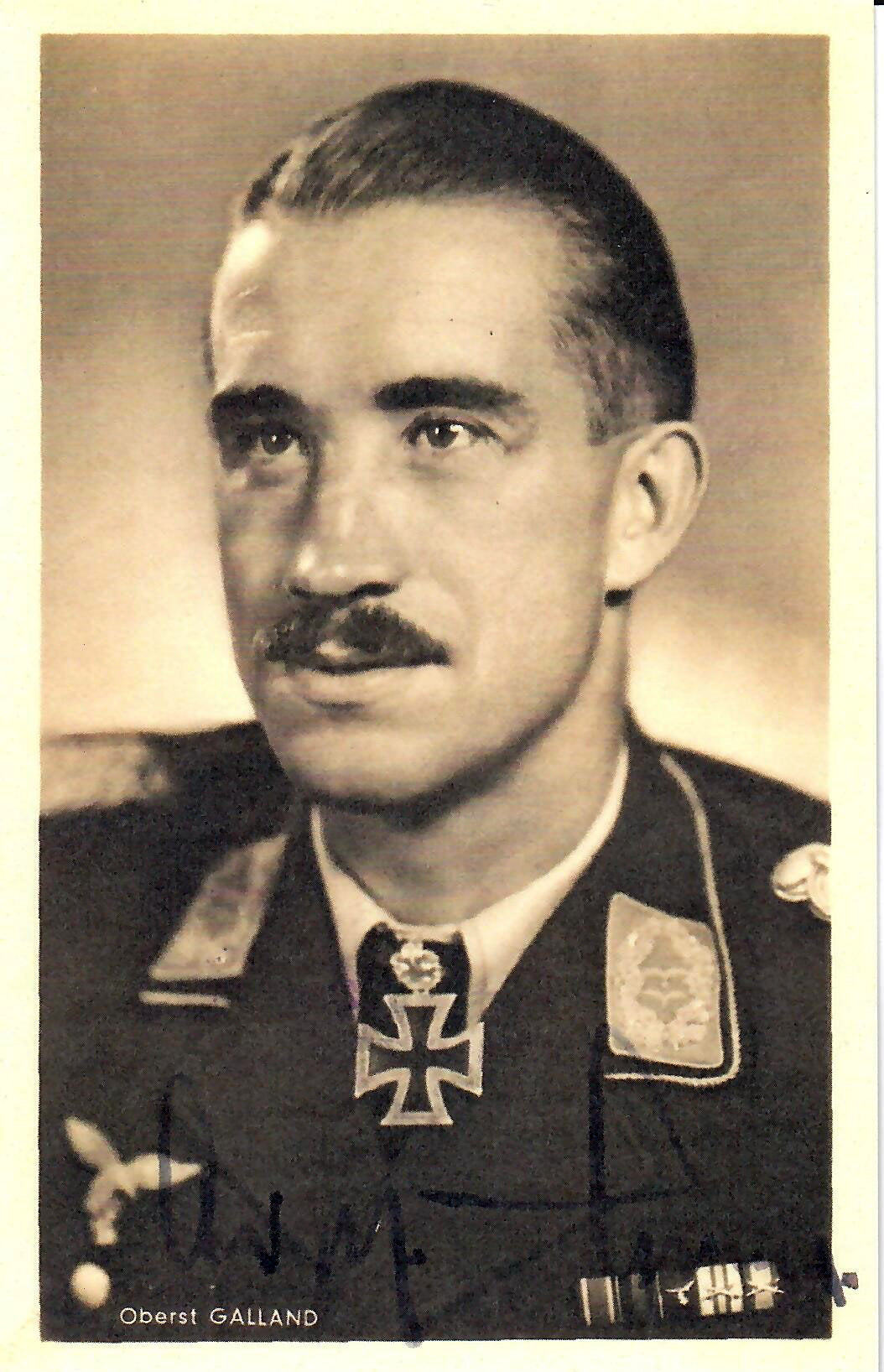Original German WWII Messerschmitt Bf 109 Tail Fin Assembly Signed by Ace Pilot and Luftwaffe General Adolf Galland Original Items
$ 39.995,00 $ 9.998,75
Original Item: One of a Kind. This is an absolutely incredible and extremely rare offering, perfect for the Luftwaffe, Aviation, or WWII Generals collector! This is a nearly complete three dimensional tail fin assembly that was cut off a plane by an American GI at the end of World War Two and shipped back to the United States as a trophy of war. Then in 1985, at an air show hosted by the Experimental Aircraft Association’s called the EAA AirVenture Oshkosh annual air show, German WWII Ace Pilot and Luftwaffe General Adolf Galland signed one side of the tail in permanent marker! Galland’s signature has been verified by multiple experts and comes with a Certificate of Authenticity.
Adolf Josef Ferdinand Galland (19 March 1912 – 9 February 1996) was a German Luftwaffe general and flying ace who served throughout the Second World War in Europe. He flew 705 combat missions, and fought on the Western Front and in the Defense of the Reich. On four occasions, he survived being shot down, and he was credited with 104 aerial victories, all of them against the Western Allies.
The tail features 90% original paint (about 2″ of the area around the base where it was cut from the aircraft was sanded and repainted), all original Swas insignia and multiple markings, as well as inspection stamping to the interior. It is constructed of aluminum and measures approximately 29″ tall x 31″ long x 3.25″ wide. It bears the original data plate that reads:
Bauart: Messerschmitt A.G.
Each-Nr 8-109-312
Werk-Nr 6446/SHersteller: Wr. Neustadter Flugzeugwerke
Along with a distinctly Germanic hand written date of 16.2.45 (February 16th, 1945)
We are not sure of the significance of the date, but it could be the day the aircraft was downed.
This tail fin is worthy of any museum or advanced collection, it is possibly the ultimate Luftwaffe piece with the exception of owning the entire aircraft!
Galland, who was born in Westerholt, Westphalia became a glider pilot in 1929 before he joined the Luft Hansa. In 1932, he graduated as a pilot at the Deutsche Verkehrsfliegerschule (German Commercial Flyers’ School) in Braunschweig before applying to join the Reichswehr of the Weimar Republic later in the year. Galland’s application was accepted, but he never took up the offer. In February 1934, he was transferred to the Luftwaffe. In 1937, during the Spanish Civil War, he volunteered for the Condor Legion and flew ground attack missions in support of the Nationalists under Francisco Franco. After finishing his tour in 1938 Galland was employed in the Air Ministry writing doctrinal and technical manuals about his experiences as a ground-attack pilot. During this period Galland served as an instructor for ground-attack units. During the German invasion of Poland in September 1939, he again flew ground attack missions. In early 1940, Galland managed to persuade his superiors to allow him to become a fighter pilot.
Galland flew Messerschmitt Bf 109s during the Battle of France and the Battle of Britain. By the end of 1940, his tally of victories had reached 57. In 1941, Galland stayed in France and fought the Royal Air Force (RAF) over the English Channel and Northern France. By November 1941, his tally had increased to 96, by which time he had earned the Knight’s Cross of the Iron Cross with Oak Leaves and Swords. In November 1941, Werner Mölders, who commanded the German Fighter Force as the General der Jagdflieger, was killed while a passenger in a flying accident and Galland succeeded him, staying in the position until January 1945. As General der Jagdflieger, Galland was forbidden to fly combat missions.
In late January and early February 1942, Galland first planned and then commanded the Luftwaffe’s air cover for the Kriegsmarine Operation Cerberus, which was a major success. It earned him the Knight’s Cross of the Iron Cross with Oak Leaves, Swords and Diamonds. Over the ensuing years, Galland’s disagreements with Reichsmarschall Hermann Göring about how best to combat the Allied Air Forces bombing of Germany caused their relationship to deteriorate. The Luftwaffe fighter force was under severe pressure by 1944, and Galland was blamed by Göring for the failure to prevent the Allied strategic bombing of Germany in daylight. The relationship collapsed altogether in early January 1945, when Galland was relieved of his command because of his constant criticism of the Luftwaffe leadership. Galland was then put under house arrest following the so-called Fighter Pilots’ Revolt, in which senior fighter pilots confronted Göring about the conduct of the air war.
In March 1945, Galland returned to operational flying and was permitted to form a jet fighter unit which he called Jagdverband 44. He flew missions over Germany until the end of the war in May. After the war, Galland was employed by Argentina’s Government and acted as a consultant to the Argentine Air Force. Later, he returned to Germany and managed his own business. Galland also became friends with many former enemies, such as RAF aces Robert Stanford Tuck and Douglas Bader. Adolf Galland died on 9 February 1996.
The Bf 109, designed by Messerschmidt and often called the ME 109, was one of the two main fighters used by the Luftwaffe during WWII, and it went through many revisions during the war. The final production version of the Bf 109 was the K series or Kurfürst (Elector), introduced in late 1944, powered by the DB 605D engine with up to 2,000 PS (1,471 kW; 1,973 hp). Though externally akin to the late production Bf 109G series, a large number of internal changes and aerodynamic improvements were incorporated that improved its effectiveness and remedied flaws, keeping it competitive with the latest Allied and Soviet fighters. The Bf 109’s outstanding rate of climb was superior to many Allied adversaries including the P-51D Mustang, Spitfire Mk. XIV and Hawker Tempest Mk. V. Introduced later in the war, there were approximately 1,700 of the Bf 109K-4 variant produced between August 1944 until March 1945, when production ceased.
As with much of the late G model (Gustav) Bf 109 instrument panels, this example is made of wood, which is correct for all of the K models produced. Late war shortages necessitated this change. The panel is in excellent used condition, showing some oxidation and deterioration, but overall is in great shape. Originally there would have been a third panel surrounding this double panel, which held the ammo counters, but that is not included with this example. We have shown a “reference example” picture of another collector’s Bf 109K-4 control, which has all of the levers, buttons, etc. installed along with the ammo counters.
Though some of the instruments have broken free of their rubber shock mountings, all are present except for the compass. All instruments look to still have their indicators intact. The various components look to be complete and undamaged, but there is no way to verify functionality. There are also many of the wires and hoses on the back of the panel still present, which are often lost or destroyed. Measures approximately 23 inches wide by 12 inches high, and probably is about 8 inches deep.
A fantastic collector’s opportunity that is unlikely to ever appear again! Ready to display as the centerpiece of your Luftwaffe collection!
The ME-109:
The Messerschmitt Bf 109, was a German World War II fighter aircraft that was the backbone of the Luftwaffe’s fighter force. The Bf 109 first saw operational service during the Spanish Civil War (1939) and was still in service at the dawn of the jet age at the end of World War II (1945). It was one of the most advanced fighters of the era, including such features as all-metal monocoque construction, a closed canopy, and retractable landing gear. It was powered by a liquid-cooled, inverted-V12 aero engine. From the end of 1941, the Bf 109 was steadily being supplemented by the superior Focke-Wulf Fw 190.
It was commonly called the Me 109 most often by Allied aircrew and even amongst the German aces themselves even though this was not the official German designation. The “Bf 109” designation was issued by the German ministry of aviation and represents the developing company Bayerische Flugzeugwerke and is a rather arbitrary figure.
It was designed by Willy Messerschmitt (hence Me 109) and Robert Lusser, who worked at Bayerische Flugzeugwerke, during the early to mid-1930s.
Originally conceived as an interceptor, later models were developed to fulfill multiple tasks, serving as bomber escort, fighter-bomber, day-, night-, all-weather fighter, ground-attack aircraft, and as reconnaissance aircraft. It was supplied to and operated by several states during World War II, and served with several countries for many years after the war. The Bf 109 was the most produced fighter aircraft in history, with a total of 33,984 airframes produced from 1936 up to April 1945.
The Bf 109 was flown by the three top-scoring German fighter aces of World War II, who claimed 928 victories among them while flying with Jagdgeschwader 52, mainly on the Eastern Front. The highest scoring fighter ace of all time, Erich Hartmann, flew the Bf 109 and was credited with 352 aerial victories. The aircraft was also flown by Hans-Joachim Marseille, the highest scoring German ace in the North African Campaign who achieved 158 aerial victories. It was also flown by several other aces from Germany’s allies, notably Finn Ilmari Juutilainen, the highest scoring non-German ace on the type, and pilots from Italy, Romania, Croatia, Bulgaria and Hungary. Through constant development, the Bf 109 remained competitive with the latest Allied fighter aircraft until the end of the war.
Fast Shipping with Professional Packaging
Thanks to our longstanding association with UPS FedEx DHL, and other major international carriers, we are able to provide a range of shipping options. Our warehouse staff is expertly trained and will wrap your products according to our exact and precise specifications. Prior to shipping, your goods will be thoroughly examined and securely secured. We ship to thousands clients each day across multiple countries. This shows how we're dedicated to be the largest retailer on the internet. Warehouses and distribution centres can be located throughout Europe as well as the USA.
Note: Orders with more than one item will be assigned a processing date depending on the item.
Before shipping before shipping, we'll conduct a thorough inspection of the items you have ordered. Today, the majority of orders will be delivered within 48 hours. The delivery time will be between 3-7 days.
Returns
The stock is dynamic and we cannot completely manage it because multiple stakeholders are involved, including our factory and warehouse. So the actual stock may alter at any time. It's possible that you may not receive your order once the order has been made.
Our policy is valid for a period of 30 days. If you don't receive the product within 30 days, we are not able to issue a refund or an exchange.
You can only return an item if it is unused and in the same state as the day you received it. You must have the item in its original packaging.
Related products
Uncategorized
Uncategorized
Uncategorized
Uncategorized
Uncategorized
Uncategorized
Uncategorized
Uncategorized
Uncategorized
Uncategorized
Uncategorized
Uncategorized
Uncategorized
Uncategorized
Australian WWII Owen MK1 Machine Carbine SMG Custom Fabricated Replica with Sling Original Items
Uncategorized
Uncategorized













































































